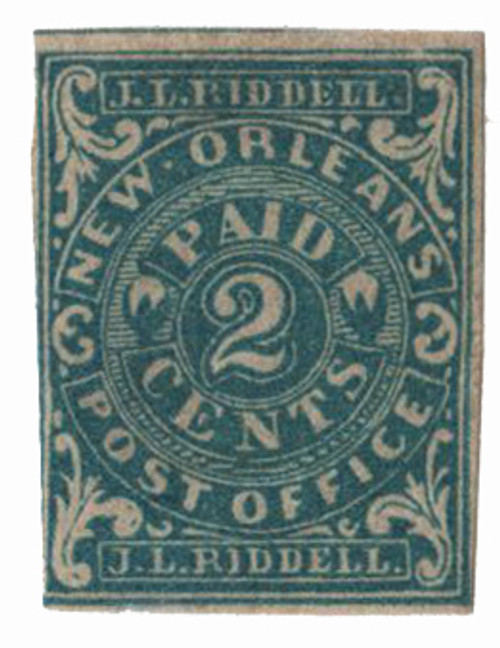
1861 2c Postmasters' Provisional of New Orleans, LA, blue
# CSA62X1 - 1861 2c Postmasters' Provisional of New Orleans, LA, blue
$175.00 - $525.00
Own a Scarce Confederate Postmasters’ Provisional Southern Postmasters Rallied in the Midst of Chaos As the Civil War loomed, the federal government ended postal service to the South. While the new Confederate government struggled to provide basic services, local postmasters issued provisional stamps for use in their cities. These provisional stamps were generally in use between June 1, 1861 when the use of United States Stamps stopped in the Confederacy, and October 16, 1861, when the first Confederate government stamps were issued. Postmaster John Riddell of New Orleans engraved his own stamp design on wood from which stereotypes were made – allowing mail in the bustling port city to continue. Get a unique piece of Civil War history – order your scarce imperforate Confederate Postmaster’s Provisional right away. United Confederate Veterans On June 10, 1889, the United Confederate Veterans (UCV) was founded in New Orleans. Click image to order. In the years after the Civil War ended, both Northern and Southern veterans began establishing their own local organizations to stay in contact with each other and provide aid to those veterans in need. In the North, Union veterans founded the Grand Army of the Republic in 1866. In the South, federal law prohibited “rebel” societies until 1878. However, several small Confederate veterans groups still organized during this time. On June 10, 1889, their representatives assembled in New Orleans and formed the United Confederate Veterans. Its constitution declared the organization’s purpose as “strictly social, literary, historical, and benevolent.” The organization provided financial support for disabled Southern soldiers and Confederate widows and orphans. It also preserved mementos and records of service for its members. The first reunion of the United Confederate Veterans was held in Chattanooga, Tennessee, on June 3-5, 1890. Invitations were extended to veterans of both the Confederate and Union armies as well as the general public. The annual reunions were very popular. During their peak years in the early 1900s, membership reached 160,000 veterans organized into 1,885 local camps. They produced a popular magazine that detailed events from the war and offered a section that helped veterans get in touch with each other. In 1901 and 1906, the UCV supported Congressional acts that called for the inclusion of over 30,000 Confederate graves in the federal cemetery system. Membership peaked in the early 1900s and began to decline as eligible veterans passed away. The last reunion was held in Norfolk, Virginia, in 1951. Three of the last 12 surviving Confederate veterans were in attendance. The reunion’s events included a reenactment of the battle of the Monitor and the Merrimac. Sons of Confederate Veterans and United Daughters of the Confederacy were formed in later years and both groups are still active today.
Own a Scarce Confederate Postmasters’ Provisional Southern Postmasters Rallied in the Midst of Chaos As the Civil War loomed, the federal government ended postal service to the South. While the new Confederate government struggled to provide basic services, local postmasters issued provisional stamps for use in their cities. These provisional stamps were generally in use between June 1, 1861 when the use of United States Stamps stopped in the Confederacy, and October 16, 1861, when the first Confederate government stamps were issued. Postmaster John Riddell of New Orleans engraved his own stamp design on wood from which stereotypes were made – allowing mail in the bustling port city to continue. Get a unique piece of Civil War history – order your scarce imperforate Confederate Postmaster’s Provisional right away. United Confederate Veterans On June 10, 1889, the United Confederate Veterans (UCV) was founded in New Orleans. Click image to order. In the years after the Civil War ended, both Northern and Southern veterans began establishing their own local organizations to stay in contact with each other and provide aid to those veterans in need. In the North, Union veterans founded the Grand Army of the Republic in 1866. In the South, federal law prohibited “rebel” societies until 1878. However, several small Confederate veterans groups still organized during this time. On June 10, 1889, their representatives assembled in New Orleans and formed the United Confederate Veterans. Its constitution declared the organization’s purpose as “strictly social, literary, historical, and benevolent.” The organization provided financial support for disabled Southern soldiers and Confederate widows and orphans. It also preserved mementos and records of service for its members. The first reunion of the United Confederate Veterans was held in Chattanooga, Tennessee, on June 3-5, 1890. Invitations were extended to veterans of both the Confederate and Union armies as well as the general public. The annual reunions were very popular. During their peak years in the early 1900s, membership reached 160,000 veterans organized into 1,885 local camps. They produced a popular magazine that detailed events from the war and offered a section that helped veterans get in touch with each other. In 1901 and 1906, the UCV supported Congressional acts that called for the inclusion of over 30,000 Confederate graves in the federal cemetery system. Membership peaked in the early 1900s and began to decline as eligible veterans passed away. The last reunion was held in Norfolk, Virginia, in 1951. Three of the last 12 surviving Confederate veterans were in attendance. The reunion’s events included a reenactment of the battle of the Monitor and the Merrimac. Sons of Confederate Veterans and United Daughters of the Confederacy were formed in later years and both groups are still active today.










